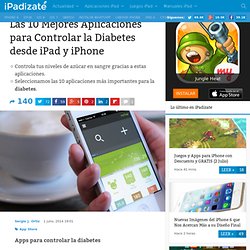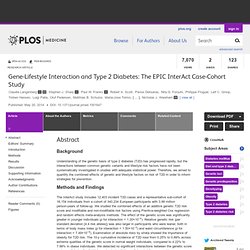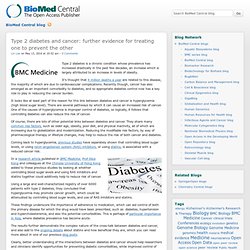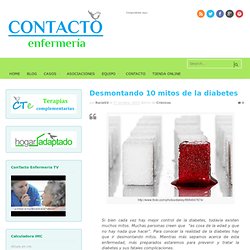

Las 10 Mejores Apps para Controlar la Diabetes desde iPad y iPhone. Apps para controlar la diabetes Con el reciente anuncio de la inminente aparición de la aplicación de Health para iOS 8, la gente y los medios hablan más de la salud y de mantenerse en forma gracias a nuestros dispositivos móviles de Apple. iOS está empezando a descubrir todo un nuevo mundo para que sus usuarios pueden interaccionar mejor con sus doctores y especialistas a través de sus iPhones y iPad.

Esto lo estamos viendo desde hace ya meses en anuncios de tv, publicidad, vídeos promocionales y aplicaciones. En iPadizate, ya publicamos recientemente una selección de aplicaciones para la dieta, esta vez vamos a preparar un conjunto de las mejores aplicaciones para diabéticos. ¡A cuidarse! Gene-Lifestyle Interaction and Type 2 Diabetes: The EPIC InterAct Case-Cohort Study.
Abstract Background Understanding of the genetic basis of type 2 diabetes (T2D) has progressed rapidly, but the interactions between common genetic variants and lifestyle risk factors have not been systematically investigated in studies with adequate statistical power.

Therefore, we aimed to quantify the combined effects of genetic and lifestyle factors on risk of T2D in order to inform strategies for prevention. Methods and Findings The InterAct study includes 12,403 incident T2D cases and a representative sub-cohort of 16,154 individuals from a cohort of 340,234 European participants with 3.99 million person-years of follow-up. Conclusions The relative effect of a T2D genetic risk score is greater in younger and leaner participants. Please see later in the article for the Editors' Summary Editors' Summary Worldwide, more than 380 million people currently have diabetes, and the condition is becoming increasingly common.
Why Was This Study Done? What Did the Researchers Do and Find? Figures. Type 2 diabetes and cancer: further evidence for treating one to prevent the other. Type 2 diabetes is a chronic condition whose prevalence has increased drastically in the past few decades, an increase which is largely attributed to an increase in levels of obesity.

It’s thought that 4 million deaths a year are related to this disease, the majority of which are due to cardiovascular complications. Recently though, cancer has also emerged as an important comorbidity to diabetes, and so appropriate diabetes control now has a key role to play in reducing the cancer burden. It looks like at least part of the reason for this link between diabetes and cancer is hyperglycemia (high blood sugar level). There are several pathways by which it can cause an increased risk of cancer. One of the causes of hyperglycemia is improper control of diabetes, so logically, it follows that controlling diabetes can also reduce the risk of cancer.
Of course, there are lots of other potential links between diabetes and cancer. Desmontando 10 mitos de la diabetes. Si bien cada vez hay mejor control de la diabetes, todavía existen muchos mitos.

RedgedapS: La metformina cuando existe alteración de la función renal. La metformina cuando existe alteración de la función renal Sobre la seguridad de la metformina (MET) hemos hablado muchas veces.

Su comportamiento fisiopatológico y su ratio riesgo/beneficio la han hecho posicionarse en el primer lugar en el tratamiento del individuo con diabetes tipo 2 (DM2). Sin embargo, la utilización de ésta, según muestran las principales Guías de Práctica Clínica (GPC), está condicionada en los individuos con alteración de la función renal. La US Food and Drug Administration requiere para su utilización niveles de creatinina plasmática inferiores a 1,4 mg/dl en mujeres y de 1,5 mg/dl en varones, la United Kingdom's National Institute for Health and Clinical Excellence (NICE), menos restrictiva, desde el 2010, permite utilizar la MET si la creatinina no excede de 1,5 mg/dl o tasa de filtrado glomerular (TFG) por debajo de 45 ml/minuto/1,73 m2 en general, y recomienda suspenderla inmediatamente si esta TFG se encuentra por debajo de 30 ml/minuto/1,73m2.
Use of HbA1c in the diagnosis of diabetes. Andrew Farmer, professor of general practice Author Affiliations andrew.farmer@phc.ox.ac.uk Be aware of clinical circumstances in which results may mislead Before 2010, guidelines recommended the measurement of blood glucose for diagnosing diabetes.

Improved standardisation in the measurement of glycated haemoglobin (HbA1c) and wider availability of the assay led to a recommendation in 2011 by the World Health Organization that HbA1c should be used instead.1 This recommendation was included within a recent UK public health guidance for the identification of people at high risk of diabetes.2 In addition, a UK expert advisory body convened by the Department of Health has—after an extended period of consultation—now stated how the WHO recommendations should be implemented.3 The expert advisory group recommends that an HbA1c cut-off point of 48 mmol/mol or more (6.5%) be used for the diagnosis of diabetes.